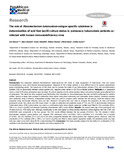The role of mycobacterium tuberculosis antigen specific cytokines in determination of acid fast bacilli culture status in pulmonary tuberculosis patients co-infected with human immunodeficiency virus

View/
Date
2018-11-08Author
Kisuya, Job
Chemtai, Alex
Raballah, Evans
Okumu, Wilson
Keter, Alfred
Ouma, Collins
Metadata
Show full item recordAbstract
Introduction: the interaction between Mycobacterium tuberculosis and HIV leads to rapid progression of tuberculosis (TB) and human immunodeficiency virus (HIV)-induced immunosuppression. Diagnosis of TB in these patients is more difficult due to its atypical presentations giving contradicting results. The overall aim of this study was to evaluate the ability of pro-inflammatory cytokine (Th1) and anti-inflammatory cytokine (Th2) to discriminate between culture-positive and -negative smear status in HIV-TB co-infected patients.
Methods: in a prospective cohort, a total of 86 study participants were recruited: 46 culture-negative and 40 culture-positive. Blood and sputum samples were collected from all participants. The blood was then analyzed using FACSCalibur flow cytometer to immunophenotype the cells and ELISA performed for cytokine profiles. Sputum samples were analyzed to determine smear status using direct microscopy and Lowenstein Jensen medium. Statistical analyses were performed using R software. Independent samples t-test was used to compare means between the two groups, while the medians were compared using two-sample Wilcoxon rank sum test. Pearson's Chi-square test was used to compare the proportion of male and female participants across the culture and AFB smear status. In order to determine the predictive power of Th1 and Th2 in discriminating Pulmonary Tuberculosis status (PTB) (culture status was used as a confirmatory test), binary logistic regression models were fitted for Th1 covariates [IFN-γ, TNF-α, IL-2 and IL-12(p70)] and Receiver Operating Characteristic (ROC) curves plotted.
Results: the overall mean age of the participants was 39 years (SD=12), 42% being male. Although, lymphocytes counts were higher in culture-positive relative to culture-negative, the CD8, CD19, and CD16/CD56 were comparable in the two groups. The CD4 counts differed between the two groups (P=0.012). The Th1 showed a better discrimination between culture-positive and -negative PTB individuals; IFN-γ (P=0.001), TNF-α (P=0.001), IL-2 (P=0.001) and IL-12(p70) (P=0.016). The Th2 cytokines (IL-4, IL-6 and IL-10) were comparable between the culture-positive and -negative groups. However, when the combination of Th1 cytokines [IFN-γ, TNF-α, IL-2 and IL-12(p70)] was fitted in binary logistic regression models, the predictive power was high with area under curve (AUC) being 89.7% in discriminating PTB.
Conclusion: this study provides evidence for the ability of a combination of Th1 cytokines in discriminating against culture-positive and culture-negative PTB.
URI
https://doi.org/10.11604/pamj.2018.31.166.17294https://panafrican-med-journal.com/content/article/31/166/full/
http://ir-library.mmust.ac.ke/123456789/1744
Collections
- Gold Collection [1021]
